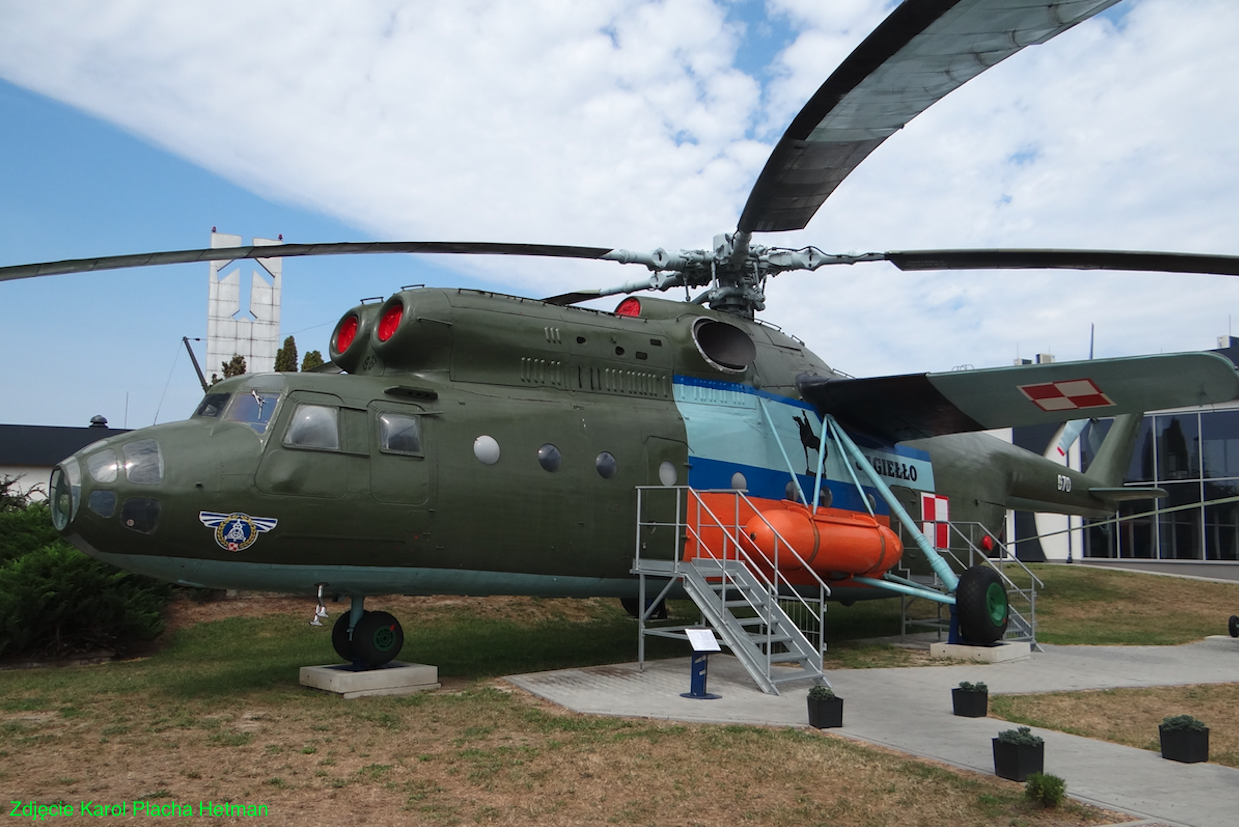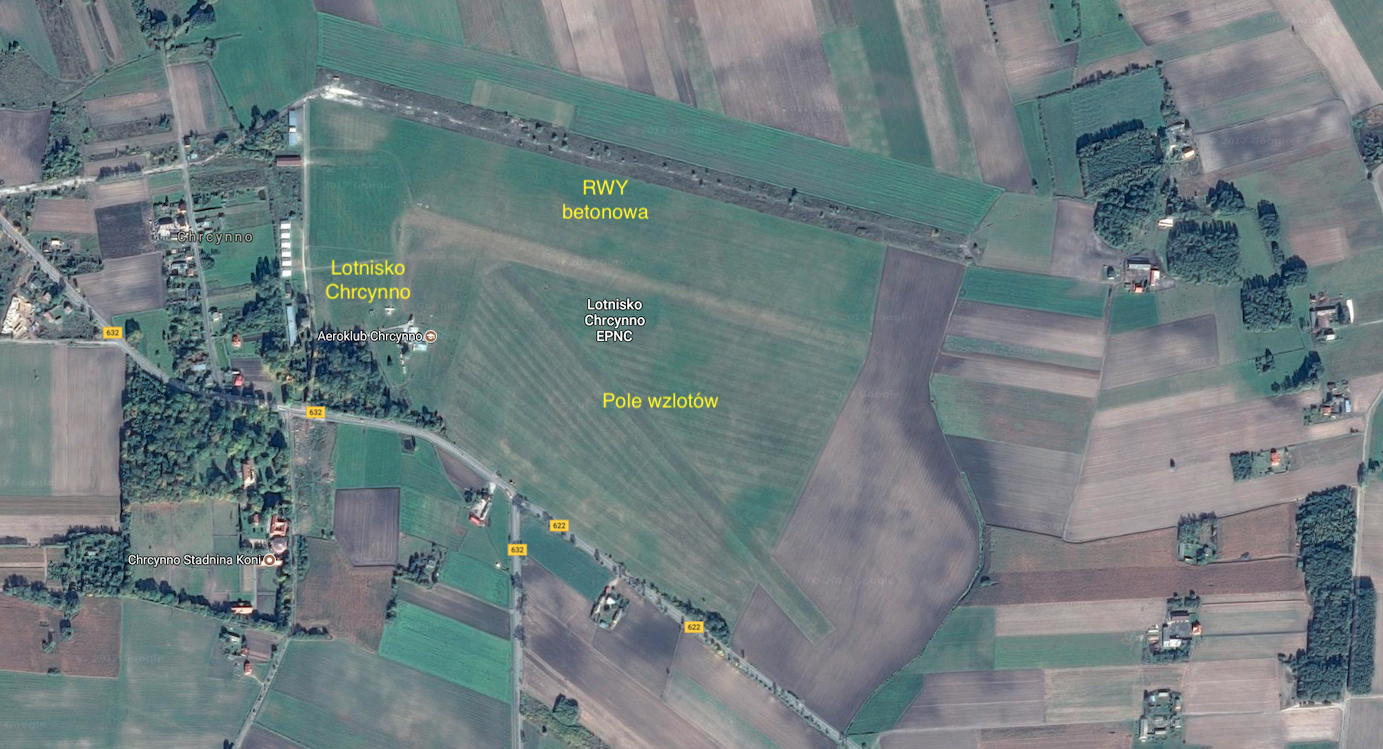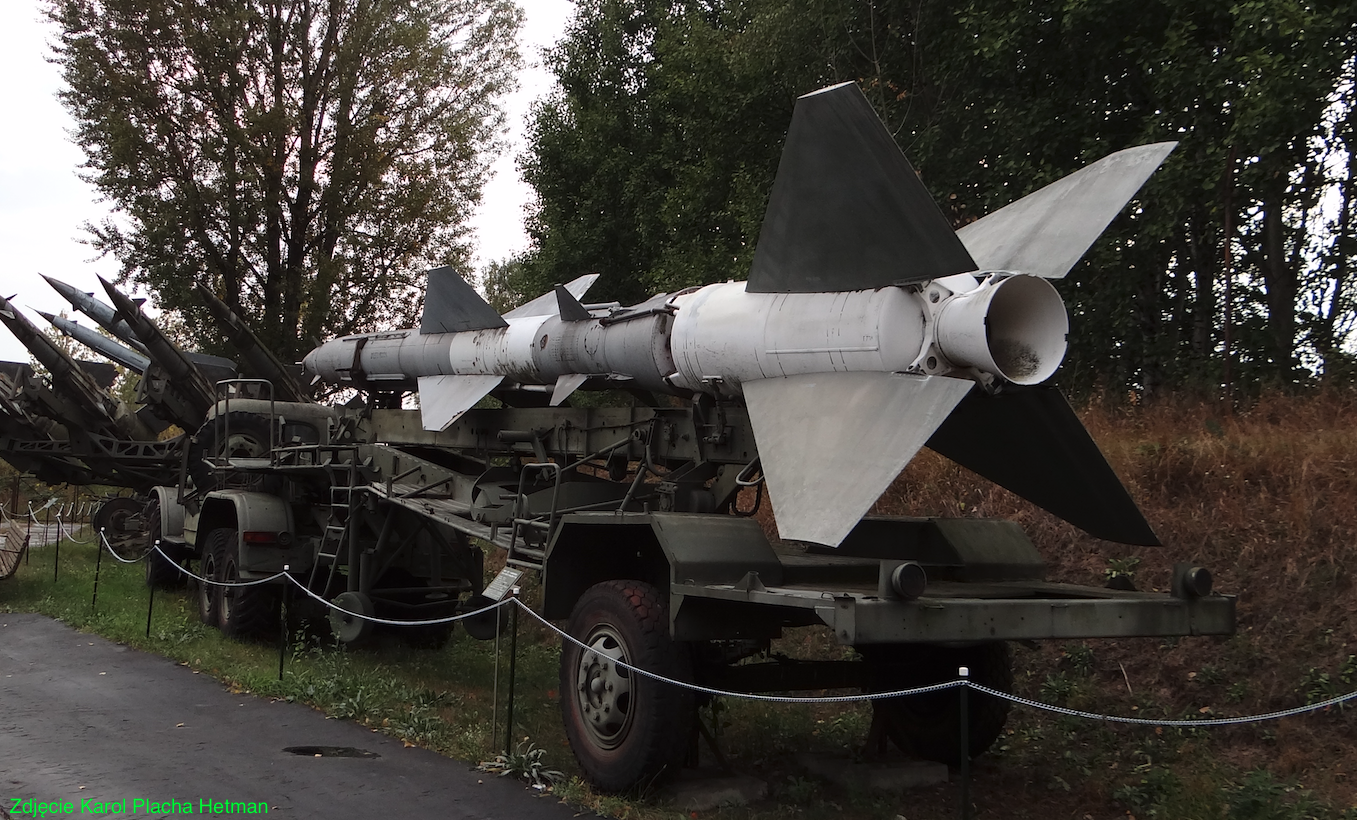Nasielsk 2017-11-27
Chrcynno airport near Nasielsk.
Geographic coordinates: 52.573N 20.872E. Elevation 107 m.



The town of Chrcynno.
Chrcynno is an agricultural town located in the Masovian Voivodeship, in Nowodwor County, in the Nasielsk Commune. It is about 5 km to Nasielsk and about 45 km to Warsaw. Chrcynno is located north of Warsaw. Provincial Road No. 632 (Marki - Płońsk) runs through the town, and Provincial Road No. 622 (connecting Chrcynno with Ludwinów Zegrze) begins here.
Chrcynno was previously called Chrzcino. In Chrcynno, the only historical building is a neo-Gothic palace from 1845, kept in good condition. In the period 1975–1998, Chrcynno administratively belonged to the Ciechanów Voivodeship, and from 1998, to the Masovian Voivodeship.
Chrcynno was one of the strategically important places in Warsaw's defense system. There are the remains of two important military facilities here: a military airport and a military complex of missile and radar units. None of these facilities are currently used by the Polish Army (Armed Forces of the Republic of Poland). Chrcynno Airport is currently used as a landing field for the Warsaw Aero Club, and the remains of the forest military complex are private land, a museum of military vehicles and rented, for example, as a paintball facility.
Chrcynno airport.
Around 1934, the authorities of the Air and Anti-Gas Defense League (more precisely, between January 1934 and March 1935) started talks with the owner of the property, Mr. Zdzisław Rościszewski in Chrcynno, regarding the construction of an airport for LOPiP. Some meadows and pastures were designated for the airport. For various reasons, mainly financial, the work was carried out slowly. Nevertheless, the take-off area was prepared to handle aircraft. The area was leveled and partially meliorated.
During the first secret mobilization, in March 1939, Chrcynno Airport was designated as an alternate airport for the 1st Aviation Regiment from Okęcie.
On September 7, 1939, the town and Chrcynno Airport were occupied by the Germanic army. In the period from March 1941 to June 1941, the Germans, with the help of forced laborers, expanded the Chrcynno Airport for military purposes. At that time, among others, a concrete runway (RWY), which exists to this day, and concrete taxiways were built. Brick buildings for the staff were built. Until November 1944, the airport served as a stage route to the Muscovites towards the east. From June 1944, it was also an operational airport due to the approaching Eastern Front. It was, among others, from this airport that Luftwaffe combat planes took off against the Warsaw Insurgents (August 1, 1944 - October 2, 1944). In November 1944, the Germans withdrew from the Chrcynno Airport. Some of the objects were blown up.
On January 15, 1945, the Muscovites occupied Chrcynno, the Airport and Nasielsk. There was further devastation of the airport. The Muscovites did not stay at the airport for long.
In the first post-war years, with the consent of the local communist authorities, the local population obtained building materials from the airport. At this time, all taxiways and the remains of brick buildings were demolished. A change in law at the end of the 50s stopped further demolition of the Chrcynno Airport. The airport was taken over by the Polish Army, which began training here. Aviation training included parachute jumping. The airport was also used for tactical exercises of newly formed military units based in nearby forests.
Instal Nasielsk.
The period 1974-1986 was unusual for the Chrcynno Airport, when one of the largest Mil Mi-6 helicopters in the world was based here.
In 1974, the first of three Mil Mi-6 A helicopters was purchased for the Polish national economy. The first Mi-6 A was received in December 1974 by the Instal company for crane and assembly work. The Instal company had its offices in Nasielsk. The helicopter was registered SP-ITA. Two more Mil Mi-6 A helicopters were purchased at the turn of 1978/1979. The Mi-6 A SP-ITB helicopter was purchased with funds from Elbud. The third Mi-6 A received the registration SP-ITC.
Since the Instal company had no helicopter pilot and no experience, a Mil Mi-8 helicopter with pilots and staff was delegated from the Polish Army. The aviation team was headed by Major Pilot Józef Wietecha. Instal also purchased a PZL Mi-2 helicopter in Świdnik.
The state treasury gave the team the pre-war, unused Chrcynno Airport near Nasielsk, belonging to LOPiP. In the future, Chrcynno Airport became the base of all three purchased Mi-6 A helicopters.
In 1975, the runway (RWY) was renovated for the needs of Mil Mi-6 A, because these helicopters usually took off with a roll of about 300 m.
The crews intended to operate Mi-6 A helicopters went to Ukraine for training, to the civilian pilot training center in Kremenchug.
Before the first Mi-6A SP-ITA was approved for use in 1974, it underwent a certification procedure based on documents obtained from CCCP and its own flights conducted by the crew of Ryszard Witkowski, M.Sc. Engineer. The research was conducted and the certificate was issued by the Institute of Aviation. SP-ITA started the first lifting and assembly works of the Mi-6 A in March 1975. The use of a helicopter for crane and assembly work has opened up new possibilities of performing work that were previously unavailable. However, very expensive.
About 90% of the work performed by Mi-6 A SP-ITA was performed for Przedsiębiorstwo Budowy Lini Energetyczne Elbud. Highest voltage power poles from 110 kV to 400 kV were erected. The greatest success was the installation of 39 power poles in 9 hours, which gave 14 minutes to erect one pole.
Other tasks included services for heavy industry, renovation and assembly works. The helicopter enabled the renovation of ironworks, spark generators, recuperators and ventilation devices. All these devices were inserted through the roof. With the traditional method, some of the buildings had to be demolished. There were no wheeled cranes as large as today. Mi-6 performed work in steelworks and foundries in Stąporków, Radom, Ursus, Grudziądz and others. Mi-6 worked in open-pit lignite mines and sulfur mines. Radio and television masts, chimneys, and domes were erected on the tops of buildings. In 1976, the monument of Władysław Jagiełło, suspended under a helicopter, traveled from Gliwice to Krakow and was placed on the prepared plinth of the Grunwald Monument, and the entire operation was shown on Polish Television. The erection of the monument was watched live by several thousand Krakow residents crowded on Basztowa Street and next to St. Florian's Church.
In 1978, Polish Mi-6 helicopters began to provide services in Hungary and Bulgaria. In the period 1975-1979, Mi-6 helicopters performed 3,200 lifting operations at a cost of PLN 323 million. It was estimated that PLN 6 billion was saved in this way.
However, the national economy, under communist rule, was in decline. Operating helicopters turned out to be very expensive. It did not reduce the costs of building power lines compared to traditional methods. Moreover, the weather played an important role, especially the wind, which could effectively stop the work.
All three Polish Mil Mi-6 A helicopters were handed over to the Polish Army in January 1986, entering service with the 37th Transport Helicopter Regiment at the Leźnica Wielka airport near Łęczyca. They received numbers 063 (ex SP-ITA), 670 (ex SP-ITB) and 671 (ex SP-ITC). They were painted dark green. The bottom of the fuselage was painted light blue. The helicopters received permanent side additional fuel tanks.
In the Polish Army, they quickly confirmed their uselessness. Three helicopters were only able to transport one company and with limited equipment. They could work better in special forces, which did not exist at that time. However, their noise was significant and the operational advantage of Mi-8 helicopters was clear.
Already in August 1990, they were withdrawn from service. Two of them were then sold to Ukraine.
The third 670 (ex SP-ITB) in 1994 went to a private museum, which was founded in the area adjacent to the Lublinek airport by Mr. Jerzy Lewandowski, owner of one of the first private planes in Łódź, pilot, member of the Łódź Aero Club and aviation enthusiast. Most of the planes in the museum were only leased. After the death of the museum's founder in 2003, the collection became the subject of inheritance proceedings that were to determine the future of the exhibits. The museum was formally closed to visitors. On November 16, 2011, the helicopter became the property of the Air Force Museum in Dęblin (which was then under construction). In December 2015, the helicopter was transported to Dęblin and underwent renovation. Since 2016, the helicopter has been open to visitors both from the outside and inside.
Next years.
In 1986, theoretically, Chrcynno Airport was still managed by the Polish Army. Around 1995, the airport was transferred to the Military Property Agency. Around 2000, Chrcynno Airport became the second airport used by the Warsaw Aero Club. The first one is Bemowo (Bernerowo) Airport in Warsaw. Chrcynno Airport is under perpetual lease of the Warsaw Aero Club.
The Warsaw Aero Club has AOC and AWC certificates, i.e. for passenger transport and air services, a fleet of Cessna 150, 152, 172, 208B, Piper Cub, AT-3 and a wide range of gliders. They train in both parachute jumping, gliders, airplanes and balloons.
In 2006, the president of the Aero Club, General Gromosław Czempiński, proposed the creation of an extreme sports center at the Chrcynno Airport. It was named "Extreme Sports Center in Chrcynno". There was even a partial agreement with the authorities of the Masovian Voivodeship. The plans also assumed the creation, in consultation with the local school, of a technical secondary school specializing in aircraft mechanics. Unfortunately, the ideas were not fully implemented.
Since 2012, the operational situation at Chrcynno Airport has deteriorated. This happened thanks to the opening of a commercial airport in Modlin. The distance between both facilities is only 20 km. Planes taking off from Modlin Airport in a north-eastern direction may enter the Chrcynno Landing Area, where parachute jumps can take place. In addition, on some maps the Chrcynno Landing is not even marked.
Currently (2017).
Chrcynno Airport is used by several entities. Private general aviation planes, motor hang gliders, paragliding and parachute equipment are kept in small metal hangars. There is a parachute and a hang gliding school. Aviation courses are organized; parachute, motor hang glider, ULM aircraft. For those looking for thrills, sightseeing flights and tandem parachute jumps are organized. Tandem jumps from a height of 4,000 m are a typical recreation for people who want to experience an air adventure. It's 40-50 seconds of free fall and 5-10 minutes in the open canopy of the parachute. Before the jump, a 45-minute preparatory course is organized. The total time of such an event is 2-3 hours stay at the airport. For those more involved, the Aero Club organizes AFF parachute training from a height of up to 4,000 m.
At the airport there is an indoor parachute, a catering point and accommodation (after prior reservation). The take-off field is used for exercises of the Air Ambulance, Police, special services, and also as a film set. Motor events, flying model competitions and gliding competitions are organized here.
Chrcynno Airport - Data.
Coordinates 52°34′25″N 20°51′37″E. ICAO airport code - EPNC, Nasielsk. The airport is registered as an airstrip. Elevation 350 ft (107 m above sea level). Kwadrat Chrcynno-Radio 122.2. First RWY 106/286 (10/28), 843 x 45 m, N52°34'26.4" E20°52'18.9" Ground surface, grass, marked lane, 843 × 45 m. Second RWY 138/318 (13/31 ), 965 x 45 m, N52°34'18.0" E20°52'19.2" Dirt surface, grass, marked strip, 965 × 45 m. The concrete RWY on the northern side of the flight field cannot be used. The parallel, grassy RWY located behind it to the north is also unusable. Telephone contact +48 236912320. Owner: Aeroklub Warszawski, ul. Moonowa 1, 01-934 Warsaw.
It is worth noting that a few years ago both runways were constructed using the geoSYSTEM lawn grid system. geoSYSTEM is a modern, ecological surface strengthening system, also known as: lawn grid, parking grid, road grid, garden grid, openwork slab, lawn panel, eco grid, geogrid. After sowing grass or using other filling, the grid becomes virtually invisible. Thanks to this, designers and investors can fully use the aesthetic values of natural surfaces and design areas with variable colors and textures. At the same time, such a surface is highly resistant to mechanical damage - running over, abrasion and trampling. Well suited for parking lots, as well as RWY for general aviation.
Access to the airport by private car is preferred. Non-motorized people can get to Nasielsk by train and then by bus, which stops after 4 kilometers 100 m from the airport buildings.
Missile and Radiolocation Troops in Chrcynno.
In October 1962, the 6th National Air Defense Missile Division, JW1033, was organized in the Chrcynno forest complex, part of the 3rd Warsaw Air Defense Missile Brigade. The unit was organized on the basis of the 86th Artillery Regiment. The new unit was equipped with SA-75 Dzvina surface-to-air missiles. The training of the first group of officers and soldiers was completed in October 1962. In 1963, the squadron performed the first combat firing at the ŁA-17MM air shield at the Ashuluk training ground in Kazakhstan, in the Moscow State. Already in 1964, the 6th National Air Defense Missile Squadron was rearmed with S-75M Volkhov missiles. In 1967, additional batteries of 37 mm anti-aircraft guns and PKM-2 anti-aircraft machine guns were added to the squadron's armament. They provided anti-aircraft cover against attacks by air attack means from low and very low altitudes. The 6th National Air Defense Missile Squadron continues to conduct heavy shooting in Ashuluk: 1966, 1971, 1976, 1980 and 1987. As part of the restructuring of the Polish Armed Forces, in 2000 the 6th DR OP was disbanded.


The forest complex covers approximately 100 hectares and is located between the towns of Nasielsk and Chrcynno. A road runs through the center of the complex, from east to west, and is now generally accessible. In the area of the former missile forces unit there is a family Armor Farm - military events for companies and a private museum of monuments of military technology. The collection includes approximately 50 military vehicles. Brothers Stanisław and Maciej Kęszycki bought the area of the former missile unit in 2004. To visit the museum, please contact the owners by phone. Address; Chrcynno 141, 05-190 Nasielsk.
Written by Karol Placha Hetman
